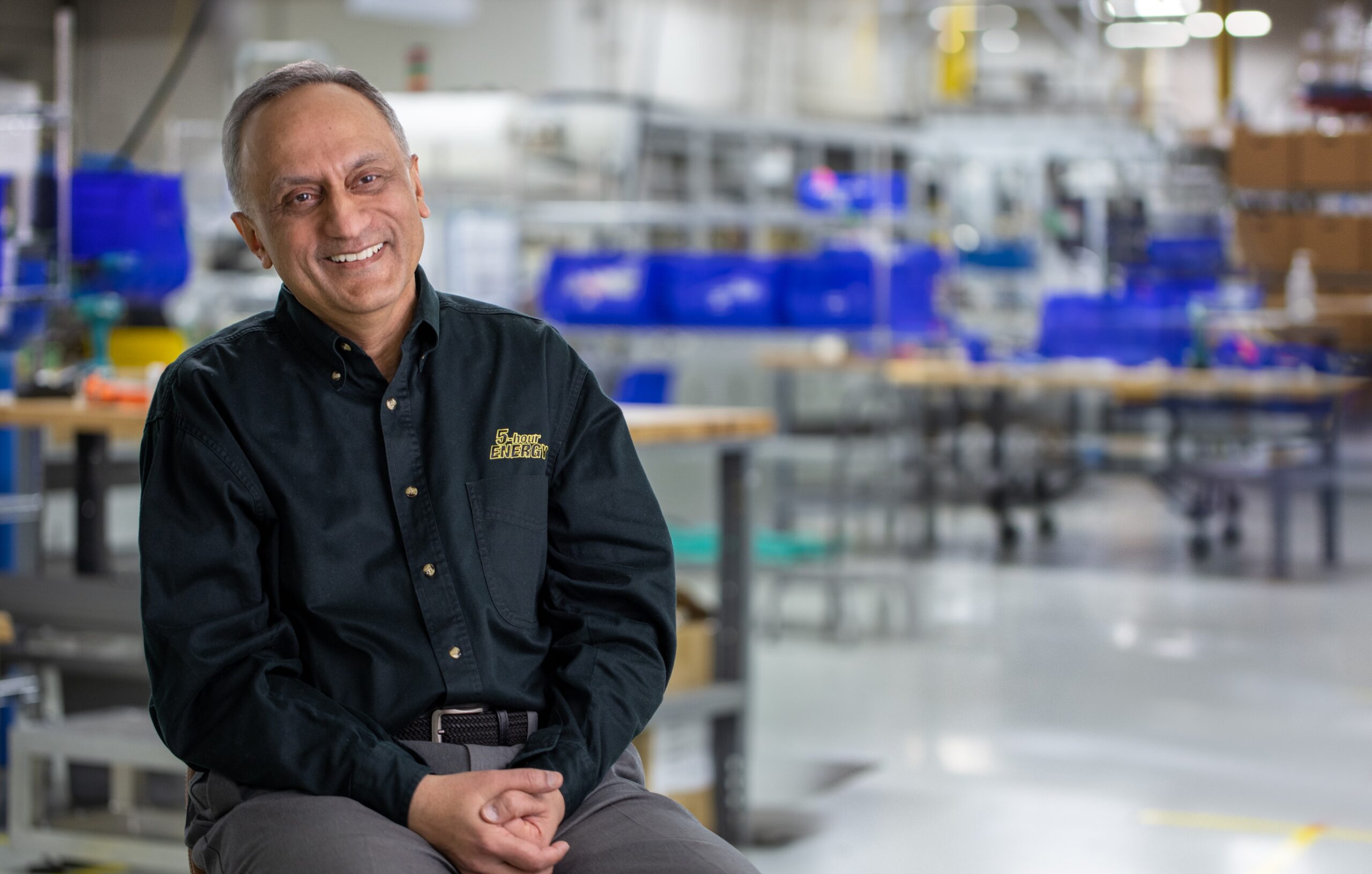


Manoj Bhargava isn’t your garden-variety industrialist. The 70-year-old former monk ran a family plastics factory in Indiana for a while but then, about a quarter-century ago, invented energy “shots” — those two-ounce cans of caffeine, taurine and vitamins that people buy at convenience-store checkouts for mental clarity and focus, or just to get through the day without nodding off.
Bhargava’s 5-hour Energy brand still manufactures its own shots, and larger energy drinks, at a plant in Wabash, Indiana. Its parent company, Living Essentials, is based in Farmington Hills, Michigan.
But interestingly, with the first $1 billion in proceeds from inventing the energy-shot category – which he notched about 15 years ago — Bhargava has pivoted to becoming a different kind of industrialist: continuously creative, serially innovative, earnestly philanthropic, perhaps sui generis, who wants to solve the world’s problems with technologies, devices and systems that he helps design, market and deploy.
That’s why Bhargava started an enterprise called Stage 2 Innovations, basically a skunkworks within Living Essentials’ 25-acre suburban complex, where dozens of scientists, technicians, engineers and others work assiduously on Bhargava’s personal goal of helping solve the biggest problems of the poorest one-third of the world.
His desire to devote nearly all of his personal wealth to that broad endeavor has taken him to developing a massively efficient reverse-osmosis method of salvaging the world’s fresh water supplies with a device that is being used in remote villages in India and elsewhere and is provided by his not-for-profit foundation; attacking the challenge of distributed electricity generation with what is essentially a solar powered battery pack that villagers can use for hours of current; reinventing fertilizer for subsistence farmers, also through Bhargava’s foundation. His enterprise also has created a mechanical therapy for mitigating Alzheimer’s disease that is nearing an FDA-approved trial.
“I look at fundamental things and something great comes out of it,” Bhargava told Chief Executive on a recent visit, while donning a cardigan and On Cloud sneakers, a brand that has become all the rage among his employees as well. “We don’t do cool stuff so much. It’s not about entertainment or convenience. There are no video games here.”
Bhargava remains heavily involved in 5-hour Energy. He also recently created two entire TV-news network, called NewsNet and Sports News Highlights, with the initial intention of making 5-hour advertising less expensive; he has added the goal of coming up with bias-free “news the way it used to be” and has employed a growing staff of journalists and producers that have brought it to life.
“There’s not that much more I can do” with 5-hour, Bhargava conceded. “I can increase 5-hour sales by a few percent, or I can do something much bigger.”
If there’s anything to be learned from a man who continues to run a multi-billion-dollar company while also helping poverty heat-stressed villages to help their teeming masses make their existence significantly better, and who’s attempting to solve major problems in health and communications as well, here are a few lessons:
Just do it. Bhargava spends pretty much every workday on the campus of his company, managing by walking around and bouncing ideas big and small off of a coterie of colleagues that keeps expanding as their leader moves into more and more verticals. “I like getting up every morning and running like hell,” he said.
Attend to your customers. Just as Bhargava created an entire new beverage category by listening to retailers, consumers and others who represented an untapped market that he exploited, he sees the cry of the world as another type of “voice of the customer,” which is why he’s trying to address the biggest problems of the poor.
“Who cares what I’m passionate about?” he says. “The needs are more important. The world’s poor are like a customer; you serve the customer. You give them what they need, not what you like to give.”
Change course if necessary. Bhargava spent decades declining to enter an energy-beverage market that already was dominated by Monster, Red Bull and PepsiCo’s Rockstar before deciding to finally make the plunge two years ago with 5-hour’s first 16-ounce carbonated cans.
“We’ve got that established 5-hour Energy name, and we can leverage that name,” he says. “The jury is still out on [our success in energy beverages]. We’ve had to develop a whole new distribution system.”
Don’t let go. At the same time he’s got huge philanthropic and industrial ambitions, Bhargava remains studiously involved in the details of keeping 5-hour Energy prosperous. For example, he personally approves and even helps formulate each new flavor. And Bhargava spends much of most days in the mechanical trenches with employees who are working on perfecting things like the device that stimulates the circulatory system to provide extra blood flow that might be the key to taking a run at Alzheimer’s.
“It’s not pharma, and it’s a non-invasive treatment that squeezes in between your heartbeats, like a secondary heart,” Bhargava explains. “It enhances blood flow, and that’s a fundamental of health. If you’ve got trash in your head and didn’t have blood flow, what would happen? It would rot, and then all sorts of bad things happen.”
Maintain your edge. The dominance of 5-hour Energy has moved the company by several years from an era during which it tangled with state attorneys general and critics over the product’s high caffeine content. Bhargava also has been known for relishing the demise of the many other energy-shot brands that have fallen by the wayside while 5-hour has continued to dominate.
Bhargava also is critical of some other billionaires who seem more interested in publicity for their causes or, in his view, have misdirected their resources.
“I look at common sense,” he said. “I don’t care what’s popular. I don’t want to be popular. I prefer to quietly do my stuff. But I’m [about] common sense. I’m a student of the obvious. I find that all the fancy folks are students of fashion.”

0

1:00 - 5:00 pm
Over 70% of Executives Surveyed Agree: Many Strategic Planning Efforts Lack Systematic Approach Tips for Enhancing Your Strategic Planning Process
Executives expressed frustration with their current strategic planning process. Issues include:
Steve Rutan and Denise Harrison have put together an afternoon workshop that will provide the tools you need to address these concerns. They have worked with hundreds of executives to develop a systematic approach that will enable your team to make better decisions during strategic planning. Steve and Denise will walk you through exercises for prioritizing your lists and steps that will reset and reinvigorate your process. This will be a hands-on workshop that will enable you to think about your business as you use the tools that are being presented. If you are ready for a Strategic Planning tune-up, select this workshop in your registration form. The additional fee of $695 will be added to your total.

2:00 - 5:00 pm
Female leaders face the same issues all leaders do, but they often face additional challenges too. In this peer session, we will facilitate a discussion of best practices and how to overcome common barriers to help women leaders be more effective within and outside their organizations.
Limited space available.

10:30 - 5:00 pm
General’s Retreat at Hermitage Golf Course
Sponsored by UBS
General’s Retreat, built in 1986 with architect Gary Roger Baird, has been voted the “Best Golf Course in Nashville” and is a “must play” when visiting the Nashville, Tennessee area. With the beautiful setting along the Cumberland River, golfers of all capabilities will thoroughly enjoy the golf, scenery and hospitality.
The golf outing fee includes transportation to and from the hotel, greens/cart fees, use of practice facilities, and boxed lunch. The bus will leave the hotel at 10:30 am for a noon shotgun start and return to the hotel after the cocktail reception following the completion of the round.